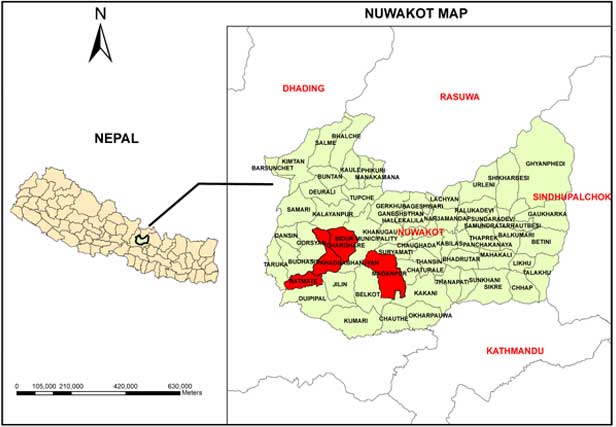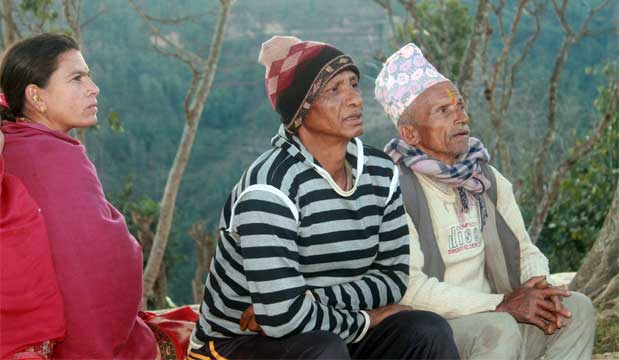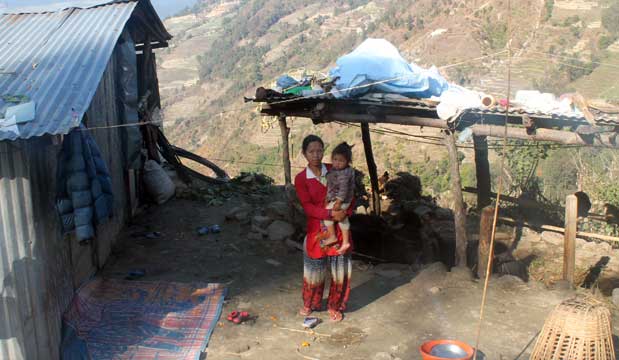By: Sangita Dandekhya, Aneel Piryani on 27 Feb 2015
Background
A research team of the Himalayan Adaptation, Water and Resilience (HI-AWARE), ICIMOD, carried out a field visit to the Nuwakot District of Nepal, in the hills of the Gandaki River Basin, for situational analysis, from February 4 to 6, 2015. The main objectives of the field visit were the following: to understand the prominent issues in the villages and how people made their livelihood; to understand climate change’s impact on the people’s lives and the vulnerabilities as well as the adaptation measures they had taken; and to identify prospective study areas for further research.
 Location map of Nuwakot district highlighting the villages visited, Prepared by Sangita Dandekhya
Location map of Nuwakot district highlighting the villages visited, Prepared by Sangita Dandekhya
We visited four government agencies in the district: the District Forest Office (DFO), the District Agriculture Development Office (DADO), the District Development Committee (DDC) and the Water Induced Disaster Control Division of Nuwakot. We also visited four Village Development Committees (VDCs): Khadga Bhanjyang, Charghare, Ratmate and Madanpur, in Nuwakot, along the Trishuli River. These villages were recommended for our research by the agencies mentioned above. In order to understand the major problems faced by the villagers, we conducted informal interviews and held group discussions with the government agencies and the local people.
Major issues identified
The people said they perceived that the frequency of extreme natural events like floods and landslides had
increased in the villages due to extensive road-construction work and increase in rainfall during the rainy season. These events have caused huge economic losses, along with some loss of human lives. We observed numerous landslides along the highway on the way to Madanpur VDC. We think these events might have occurred due to lack of proper Initial Environmental Examination (IEE) and Environmental Impact Assessment (EIA).
 Local participants in a group discussion in Charghare VDC, Photo by Nabin Bhattarai
Local participants in a group discussion in Charghare VDC, Photo by Nabin Bhattarai
The scarcity of drinking water is the other main problem faced by the people in these hilly villages. Before the construction of public taps in the villages in 2018 BS, most of the people in Khadga Bhanjyang and Charghare used to travel long distances to fetch water from the river and spring sources, without considering their quality. Today, approximately, 30 households get water from each public tap, which provides a limited amount of water for a limited time. Similarly, in some villages in Ratmate and Madanpur, people had constructed a small-scale drinking water system by themselves and had also dug wells along the Trishuli River’s bank. They had invested their own funds and resources to create the system. In some of the villages, the VDC and DDC also provide some sort of assistance in the form of funds, technical assistance and resources. But we learned that landslides usually sweep away the available drinking-water pipeline, which further exacerbates their water problems. Respondents also mentioned that water sources were drying up in some places.
In almost all the villages, the farmers are drawn to cultivating hybrid varieties of crops, rather than traditional crops, as the hybrid crops produce high yields. However, the farmers cannot store the seeds from the hybrid crops for use in the following year, like they used to with traditional crops. They are thus compelled to buy seeds every year, and they are worried about what they will grow should the hybrid seeds become scarce in the market. Some farmers also complained about the emergence of disease in their crops. Some farmers also complained about the emergence of disease in their crops. Some people also said that the unreliable rainfall patterns were affecting their rain-fed crops and their yields.
 Local woman explaining her water woes, Photo by Nabin Bhattarai
Local woman explaining her water woes, Photo by Nabin Bhattarai
The other major agriculture-related problem has to do with poor irrigation infrastructure and its management. The irrigation canal network is not robust; the earthen canals see high seepage losses; landslides and floods cause damages to the canals every year; and the villagers have to conduct yearly maintenance on the canals. Furthermore, there are frequent conflicts among farmers brought about by the poor management of the water canals and a high demand for water during the peak seasons. In addition, the lack of irrigation facilities in some areas of the villages has forced farmers to practice rain-fed irrigation.
The well-off households of the villages had already migrated to and settled in urban areas such as Kathmandu. There has also been an increase in migration by the youths and working male family members—for education and employment—to Kathmandu and the Gulf countries. The money made by the migrants means the families now have good cash income, but the migrant workers’ absence had increased the work-burden on the females and elderly. However, the money made abroad also allowed some families to branch out into areas other than traditional agriculture. A Tamang farmer from Madanpur, who had returned from the Gulf, has for example, started commercial-vegetable farming and trout farming and is also rearing goats and buffaloes. Through these ventures, he is making more income than he used to earlier.
The health and sanitation facilities in the villages are very poor. Some villages do not even have a health post, and people do not have toilets and proper sanitation facilities in their houses. Furthermore, the majority of the villagers are illiterate and lack awareness on issues pertaining to safe drinking water, health and sanitation.
 A local lady from Mandanpur VDC whose husband is a migrant worker in Saudi Arabia, Photo by Aneel Piryani
A local lady from Mandanpur VDC whose husband is a migrant worker in Saudi Arabia, Photo by Aneel Piryani
Caste-based discrimination is prevalent in the villages even today, and the so-called lower caste people in the villages still suffer on account of it. The local dairy, for instance, refuses to buy the milk and dairy products from the ‘Bikka’ (the lower caste people) in Archale, Charghare VDC. We observed that the lower caste people didn’t fare any better in Madanpur and Charghare VDCs.
Point to ponder
The increase in the occurrences of extreme events, the drying up of the water sources, the people’s perception of increased rainfall and changes in rainfall patterns and the increase in incidences of diseases in crops show that climate change is causing adverse impacts on the villages. The coupling of climate change’s impacts with the prevalent socio-economic problems (such as poverty, illiteracy, caste-based discrimination and marginalisation of some of the people, and out-migration) has accentuated the
vulnerability of the poor and low-caste people in the villages, so proper adaptation measures may need to be tried, taking into consideration the local context!
